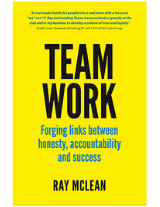Feedback is the driving force for growth, high-performance and trust-building within relationships and teams. It’s the mirror that reflects our blind spots and areas we might overlook to provide us with valuable insights into behaviour and potential obstacles.
By sharing genuine and constructive feedback, you can encourage learning, self-awareness and growth for your people, which keeps you ahead of the game and ultimately improves your team’s performance.
For leaders, mastering the art of giving feedback is not just a skill; it’s a fundamental leadership function that shapes the path to individual and collective success. So, how do you give effective feedback that benefits everyone involved? Let’s explore.
How to give feedback to your team
As humans, we instinctively engage in micro-moments of communication every day—whether it’s an encouraging pat on the back for a teammate or a subtle nod of appreciation to the boss. But when it comes to giving feedback in the workplace, instincts will only get you so far.
As experienced facilitators, we know that genuine conversations and meaningful connections underpin positive feedback outcomes. So, fostering open lines of communication and trustworthy relationships is crucial for effective team leadership.
When relationships are nurtured and communication is encouraged, you can focus on other important aspects of giving feedback to your team.
Here are our top tips for providing effective feedback:
1. Understand your team and be their advocate
Building a culture of open communication and continuous improvement starts by understanding your team and advocating for their rights. In addition to working in a safe and inclusive environment, they have a right to:
- know what is expected of them
- know how they are performing
- know what they need to do to improve and upskill
- know what the outcome of their performance or behaviour will be
Leadership styles, employee learning styles and behaviour types can impact how you deliver and manage feedback, so look for training and development opportunities to expand your knowledge.
2. Develop a team Trademark
A team Trademark is an agreed set of norms and behaviours around team culture, perception and conduct. Team trademarks often evolve from the team’s culture, values and purpose. These values can provide a solid foundation and context for giving feedback.
3. Define a goal and plan ahead
Before you jump into a feedback meeting, ask yourself what the goal of this conversation is. Effective feedback involves preparation, delivery, and follow-up. Determine what you want to achieve and how best to approach the conversation.
The success of your feedback depends significantly on choosing the right moment and setting. A neutral, private space is best for more sensitive discussions.
4. Provide clear and constructive feedback
Studies show that adopting a future-focused approach to giving feedback is more likely to motivate people than dwelling on their missteps or failures. You can achieve this by aiming to:
Creating space for a respectful, two-way dialogue encourages communication, which opens the door to forward-thinking solutions and future goals.
To enhance the impact of your feedback it helps to:
- Be empathetic and compassionate.
- Focus on trademark behaviours and solutions rather than the person.
- Use constructive language and provide context that explains why the feedback matters.
- Base your feedback on observable facts (not hearsay) and clearly communicate your core message. Clarity and brevity can mitigate misunderstandings.
- Position feedback in a way that highlights opportunities for development while acknowledging strengths.
- Don’t assume anything.
- Provide ideas, strategies and actionable advice.
- Set clear expectations for the next steps and follow up accordingly.
- Offer learning and development support where relevant.
By focusing on future possibilities, encouraging open dialogue and offering supportive and actionable guidance, you can become a high-performing leader and create an environment where feedback is not just a critique but a valuable step towards personal and professional development.
How to give feedback to your manager
Offering feedback to a manager calls for thoughtfulness, diplomacy and respect. Approaching each conversation with a collaborative mindset focusing on shared objectives and the team’s overall success can lead to more constructive outcomes.
Here are our top tips for giving feedback to your manager, department head or senior leader.
- Define a goal and plan ahead
- Structure the feedback
- Offer solutions, not just problems
- Be respectful and professional
- Follow up
It’s important to think about the goal of your feedback. Who is the feedback affecting, what is your desired outcome and how can that be achieved?
Avoid vague generalisations, be specific and focus on particular incidents or behaviours to ensure your feedback is clear and actionable. This approach will help keep the conversation constructive and solution-oriented.
Tailor your approach based on how your manager typically gives feedback. If they tend to be direct, they might appreciate you being direct. If they’re more reflective, they might appreciate a more detailed discussion.
Also consider the timing of your conversation. Opt for a private space in a comfortable setting when your manager is more likely to be receptive.
Using a review tool to structure feedback can be helpful for both parties. At Leading Teams, we use a peer review system based on the ‘stop, start, keep’ method, which explores one to two things someone can stop and start doing, followed by a series of things they can keep doing. This creates balance when discussing what’s working and areas for improvement.
Suggesting practical ways to address or overcome the issue shows you’re committed to a positive outcome.
Keep it respectful and remember that your goal is to improve things rather than point fingers. Avoid humour and sarcasm and go into every feedback conversation with an open mindset. Why? Because you don’t know what you don’t know until someone else shares their perspective or considerations.
Acknowledge the opportunity to share your thoughts with your manager. Schedule a follow-up meeting or a casual chat to explore changes or progress if necessary.
By approaching the feedback process with preparation, respect, and a focus on constructive solutions, you can effectively communicate with your manager and contribute to a positive work environment.
Examples of giving feedback well
Consider these examples:
- Project feedback: “Thanks for working on the report – it was really comprehensive. Including more data analysis next time could enhance its impact even further.”
- Behavioural feedback: “I’ve noticed that you tend to interrupt in meetings because you’re excited to share your views. Using the reaction tools or chat box could improve our team discussion flow.”
These examples are impactful because they are clear, specific and focused on improvement.
Giving feedback is a skill
Providing effective feedback is an integral aspect of leadership, crucial for the growth of individuals and teams. It requires a blend of empathy, clarity, planning and strategic thinking. By steering clear of feedback pitfalls and nurturing a culture of open communication and mutual respect, you can significantly improve results and help to build a high-performing team.
Master the art of giving feedback and take your team’s performance to the next level with our Performance Improvement Program.
Further reading:
What is a high-performing team?
How do you respond to feedback?
Retaining and engaging your team through culture
Jake joined Leading Teams full-time in 2016 after first working with us as an athlete facilitator from 2000.
Learn more about Jake.




